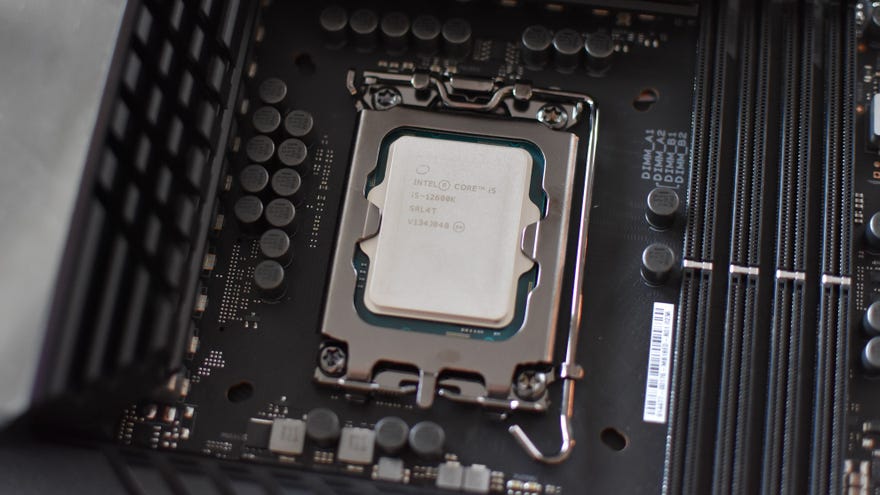Intel Core i5-12600K review: a gaming CPU worth waiting for
Intel’s 12th Gen Alder Lake chip outmuscles the Ryzen 5 5600X
The Intel Core i5-12600K is, in some ways, the CPU that Intel should have made three or four years ago. Ever since AMD’s Ryzen chips appeared with an alluring balance of gaming speed, desktop multitasking performance, efficiency, and affordability, Intel seemed to sink into a comfort zone of simply raising clock speeds and maybe adding a few cores.
This was often enough to earn some half-throated recommendations for gaming builds specifically, but this past year proved that something needed to change, with the AMD Ryzen 5 5600X claiming the best gaming CPU title and 11th Gen Rocket Lake Intel chips – like the 5600X’s rival Core i5-11600K – looking thoroughly skippable. For those who did decide to wait until the 12th Gen Alder Lake launch, consider yourselves vindicated, as the Core i5-12600K is a great all-rounder: both a Ryzen-beater in games and, thanks to a long-overdue architecture revamp, a drastically better general purpose processor.
Whereas previous Intel CPUs were comprised of a bunch of identical cores, Alder Lake splits them up into larger, faster Performance cores (P-cores) and smaller Efficiency cores (E-cores). The Core i5-12600K has six P-cores and four E-cores, not to mention Hyper-Threading bringing the total thread count to 16, so it already has a numbers advantage on the hexa-core Ryzen 5 5600X and Core i5-11600K. The idea is to spread the workload more effectively: E-cores pick up background processes and less power-hungry apps, while the P-cores can go to town on more demanding tasks (like games) without having to share as much power or heat as if the E-cores were the full-size cores of old.
Alder Lake, in general, also brings support for DDR5 RAM and PCIe 5.0 hardware. You won’t find any of the latter on the market for a few months at least, though PCIe 4.0 support comes as standard as well.
Before we look at how the new design handles some benchmarks, a word or several about my testing setup. I paired the chip with an Nvidia GeForce RTX 2080 Ti Founders Edition, as per usual, but because Alder Lake chips require the also-new LGA 1700 motherboard socket and an Intel 600 series chipset, I swapped in an Asus ROG Maximus Z690 Hero (£520 / $600) motherboard. This in turn requires the use of DDR5 memory, so I used 16GB of Geil’s Polaris RGB DDR5.
DDR5 memory is launching in a similar state to DDR4 when it was new, which essentially means faster frequencies (how many RAM cycles are performed per second) than the previous generation but also much higher latency (how quickly the RAM can send data to the CPU). My Geil DDR5’s frequency tops out at an immense 4800MHz, but its latency timings of 40-40-40-77 would be pretty dismal by DDR4 standards now that the latter has matured and improved.

There are other under-the-hood differences between DDR5 and DRR4, but for now I’m going to stick with the stock frequencies and compare gaming performance to older chips as they were tested with DDR4 on a 4000MHz XMP profile.
With the motherboard and memory in place, I installed the Core i5-12600K with an Asus ROG Ryujin II 360 liquid cooler and started with the Cinebench R20. And, holy moly:
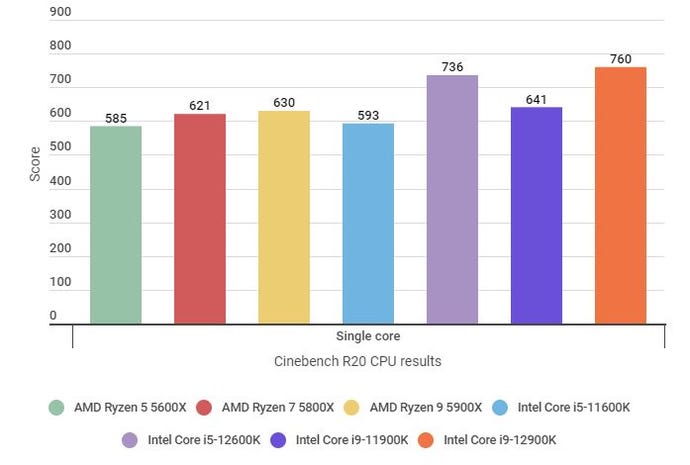
At last, a truly generational upgrade from an Intel chip! Although the Core i5-12600K’s highest P-core Turbo speed of 4.9Ghz is equal to that of the Core i5-11600K, and its 3.7GHz base clock speed is actually a little lower, it looks like architectural improvements are enough to produce a major jump in single core prowess. Both previous Intel chips and the Ryzen 5 5600X are left well behind, and the Core i5-12600K even keeps pace with its twice-as-expensive Alder Lake stablemate, the Core i9-12900K.
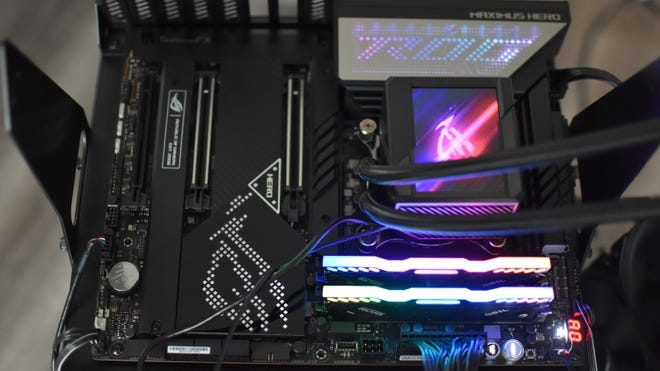
The bonus E-cores and upgraded task scheduling also make a big difference in multitasking. Historically this is AMD’s turf, but while the Core i9-12900K claims the premium end as its own, this is the first time that we’ve seen a mid-tier Intel chip trounce its AMD equivalent. And again, this is with high-latency RAM. What an excellent showing for the 12th Gen’s reworked, more multithreaded design.
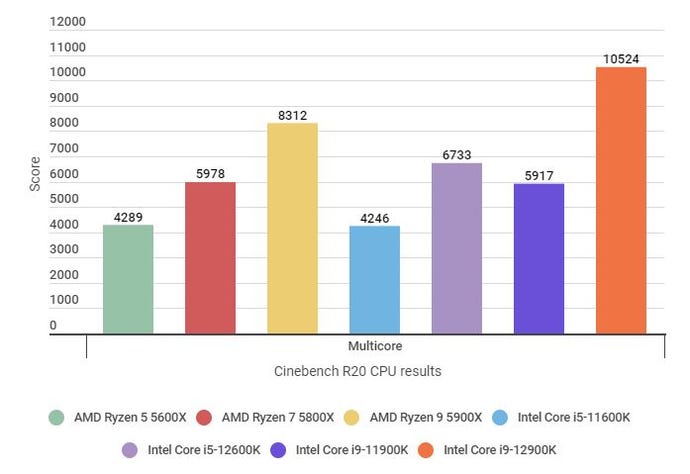
Given these results, I wouldn’t blame anyone for smacking their lips at the thought of potential gaming gains, as if replacing their old chip with Core i5-12600K would see a previously creaking rig burst into life like the grandad in Charlie and the Chocolate Factory. As it turns out, there are gains to be had, though switching up between P-cores and E-cores definitely doesn’t have as transformative an effect as it does in desktop multitasking.
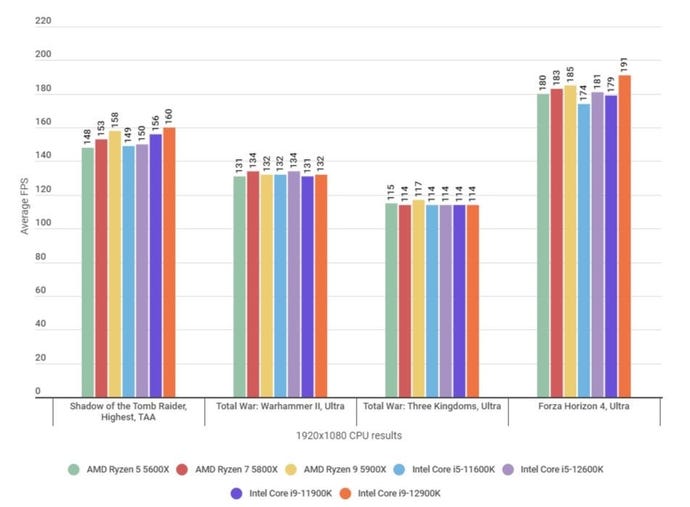

The Core i5-12600K is inarguably better than the Ryzen 5 5600X or Core i5-11600K in games, it’s just sometimes by very small amounts. This is surprising, considering how much more raw single core power it apparently has, but then you can see relatively significant improvements in games that can exploit multithreading more effectively. Assassin’s Creed Valhalla, which is the first AssCreed game to support DirectX 12 and its multicore enhancements, did particularly well with the Core i5 12600K; the same goes for Forza Horizon 4, which is also a multicore-optimised game.

There’s an argument to made that the Ryzen 5 5600X still comes close enough to the Core i5-12600K while using less power, and while costing slightly less. Even so, I reckon the extra 20-odd quid is worth paying: you’re getting dramatically better performance in everyday desktop usage, and although gaming-specific improvements aren’t as impressive, there’s no compelling reason to turn them down, especially if you own one of the best graphics cards and want to wring every last drop of potential out of it.
As for Alder Lake’s features, DDR5 support needs latencies to improve before it can be a clear upgrade over DDR4, but the rest is all good. The additional PCIe 4.0 lanes, for instance, will let you add more of the best SSDs than Rocket Lake ever would, and PCIe 5.0 support is at least handy for futureproofing.

Unlike the Core i9-12900K, the Core i5-12500K can also get by on basic cooling. In addition to the ROG Ryujin II 360, I tested temperature performance with a 240mm Corsair H100i Elite LCD liquid cooler and a cheap Cooler Master Hyper 212 Evo V2 air cooler. As you can see from the results below, the i5 always stayed well within safe temperature ranges after a few runs of Cinebench R20’s toughest test:
| Asus ROG Ryujin II 360 | Corsair H100i Elite LCD | Cooler Master Hyper 212 Evo V2 | |
|---|---|---|---|
| Cinebench multicore average temps (°c ) | 60 (P-cores), 48 (E-cores) | 60 (P-cores), 47 (E-cores) | 67 (P-cores), 52 (E-cores) |
| Cinebench multicore peak temp (°c ) | 67 (P-core) | 64 (P-core) | 71 (P-core) |
With the Asus cooler specifically, I also recorded the P-cores staying within a very healthy 30-40°c range during the Shadow of the Tomb Raider benchmark, as well as within the 25-35 °c range while playing Horizon Zero Dawn. The E-cores were always even cooler, though weren’t being utilised much.
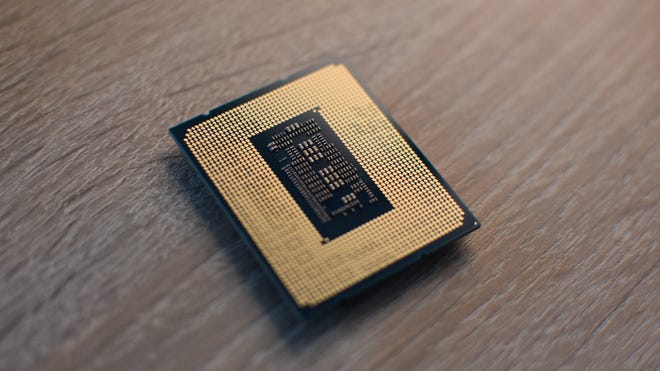
While it’s clear that Alder Lake’s architectural overhaul benefits multitasking more than straight frames per second, it’s ultimately enough for the Core i5-12600K to displace the Ryzen 5 5600X as the best gaming CPU for most people. It’s faster, smarter, and more ready for the PC hardware of the future – and unlike with Rocket Lake, there’s no threat of a drastically better Intel generation launching a few months later. If you passed over the 11th generation to see how the 12th turned out, you can stop waiting; just make sure you’re matching the CPU to the right motherboard and RAM, should you take the plunge.
